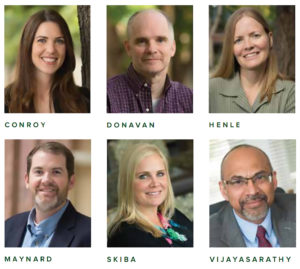
When we think of “business research,” we think of two different kinds of information gathering.
There’s the operational market intelligence every business needs: potential customers, competitors, and capital. Entrepreneurs, especially, find there is no shortage of practical resources to help launch and sustain a company – and advisors to help them locate and make sense of those resources.
Then there’s the rigorous scientific analysis of the nature and role of business done within the academic setting. Academic business research is a relatively new field; it only gained prominence in the years just ahead of the opening of the Colorado State University College of Business in 1966, spurred by a national call for business schools to follow the professional lead of engineering and medical schools. The result: more scientific methods – data, models, measurements, systems and analysis — used to study how business works.
“At its core, research in business seeks to understand how individuals and firms make choices under constraints, and what the results of those choices are on different stakeholders; the factors that influence individual and aggregate consumption, investment, and production decisions; the role of uncertainty in decision making; and the organizational ingredients that spark human ingenuity and societal progress,” explained Sanjay Ramchander, professor of finance and associate dean for academic programs in the College of Business. “These questions continue to excite the imagination and work of researchers in the business discipline.”
CSU had long offered practical classes in line with the how-to nature of the University’s land-grant mission – typing, bookkeeping, accounting and similar courses – as well research projects that addressed specific operational needs of Colorado businesses. This “vocational” approach continued during the first two decades of the college, as Dean Don Dobler and his crew concentrated on creating both undergraduate and graduate programs, attracting students, and expanding outreach through distance education.
Starting in the 1980s, the college became much more aggressive in recruiting faculty who could bring an added dimension of robust research – and academic prestige – to their teaching. Since then, College of Business researchers have been making an impact with their work, for example:
- An article co-authored by marketing professor Doug Hoffman in 1995 – “Tracking Service Failures and Employee Recovery Efforts” — was just named the most outstanding contribution to the Journal of Services Marketing in the publication’s 30- year history.
- Kelly Martin, completing research under her two-year Monfort Professorship, won the 2016 Thomas C. Kinnear Award from the Journal of Public Policy and Marketing.
- Management professor Daniel C. Ganster is the author of one of the most highly cited papers in the field of management, “Work Stress and Employee Health: A Multidisciplinary Review.”
In addition to winning prestigious awards, research performed by College of Business faculty serves government and society — accounting research informs congressional committees and standard-setting bodies about the effects of various proposed rules or legislation; management research informs public policy regarding employee health and safety practices; and finance research investigates how commodity and security prices are affected by various factors.
College researchers, including Kathleen Kelly, Gina Mohr, and Samantha Conroy continue to explore important topics such as how business- and marketing-based approaches can have a positive influence on the behaviors of at-risk youth or improve nutrition awareness among consumers, or why employees are more productive not checking email over the weekend.

“Business research rarely aligns perfectly with a particular firm’s situation at a particularly point in time, but is important for understanding how the market operates,” Ganster said. Such understanding has helped whole industries move forward, for example, by developing best practices for managing teams of auditors or in the surgical suite.
But to make a difference, such findings must be vetted and shared through publication in peer-reviewed journals.
“Our research is evaluated on the basis of its theoretical, empirical, and methodological contributions,” said Ken Manning, associate dean for research and faculty, and co-author of a recent study evaluating the effect of specific types of messaging on children’s consumption of sugary foods. “Fellow academics critique our work against the literature and current understanding of business.”
And that’s where some of the greatest controversies in the field arise.
“Many in the academy have debated over the years about whether academic research has remained relevant to businesses, and people have disagreed on the extent to which this is true, or even as to whether it should be the main concern,” said Ganster. “But what drives faculty choice of research topics is mostly their judgment about what topics will ‘sell’ in the peer-reviewed journals.”
With the explosion in the number of researchers around the globe competing for a relatively stable number of pages in the top journals — the ones faculty are expected to publish in to get tenured or promoted — Ganster estimated the article rejection rate to be above 95 percent. “Those are pretty low odds for a faculty member who has spent a year or two conducting a study with hopes of publishing it in a top journal.”
Standards for publication are also getting tougher, according to Manning. “Editors and reviewers are expecting more and more in terms of the number of studies included in a paper, the quality of measures, use of multiple methods, more field-based data, and so on,” he said, adding that the “low-hanging fruit” of topics has already been examined, so it becomes increasingly challenging to identify novel contributions.
Ramchander, for one, sees this as a relatively positive development.
“We hope to have an impact via our work,” he said. “I think the scarcity/high value of journal pages is creating a system in which you do not get published unless you truly have something important to say.”
Into the future
 Technology has also had an impact on College of Business researchers, mostly for the better, but with some challenges as well.
Technology has also had an impact on College of Business researchers, mostly for the better, but with some challenges as well.
“Research methods have become much more sophisticated over the years, especially in terms of statistical techniques,” said Ganster, who has been a researcher for nearly four decades. “For instance, I routinely do intensive ‘bootstrapping’ statistical estimations on my laptop in seconds that really did take hours on a supercomputer in the 1980s and even 1990s. Many of the statistical techniques that I routinely use now in my own research were not even invented when I completed my doctoral program. This means that faculty members need to continually keep up just with learning new analytical techniques in order to be competitive.”
The biggest challenge for faculty, who must balance their research pursuits with teaching, is finding the time to do it all. Manning said the college is working hard to provide faculty with this scarcest resource, in part by extending contracts beyond the traditional nine months to support research over the summer months.
“With all of these challenges I am constantly amazed at the success of our faculty here,” Ganster said. “They are talented and they are dedicated to their craft.”